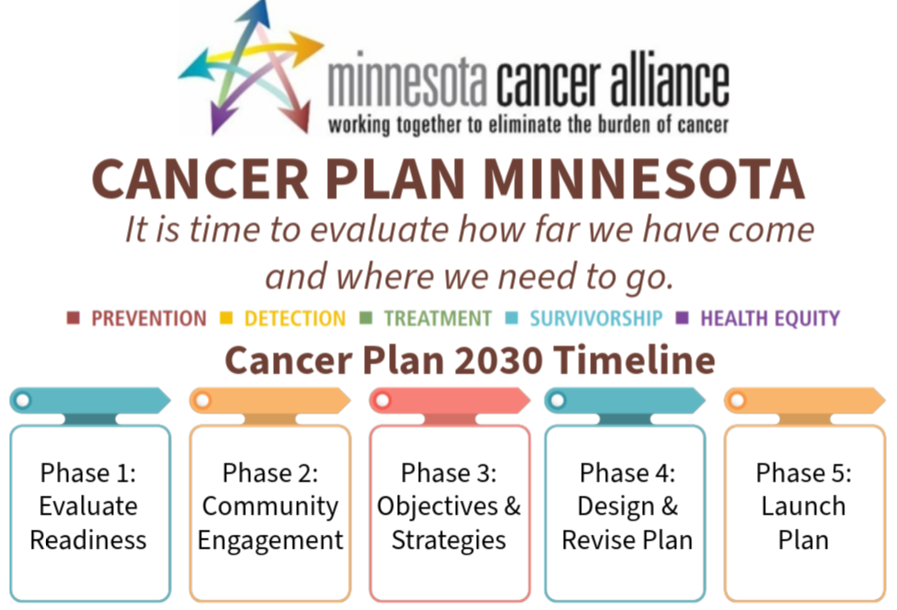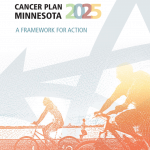
cancer plan minnesota 2025
Cancer Plan Minnesota is a framework for action that invites everyone to get involved in reducing the burden of cancer and promoting health equity. It challenges organizations and individuals in every sector and every region of the state to step up, work together and make a difference for all Minnesotans.
Five overarching goals have guided the MN Cancer Alliance since its founding in 2005. They continue to guide the current work and provide an organizing structure for this plan: Prevention, Detection, Treatment, Survivorship, and Health Equity.
The Minnesota Department of Health’s Comprehensive Cancer Control Program staff, The MN Cancer Alliance’s Steering Committee, a Legacy Advisory Team, and more than 30 listening sessions and online feedback ensured the process of crafting Cancer Plan Minnesota was inclusive, open and forward-thinking. Their input informed six workgroups that recommended objectives and strategies for the plan. Three criteria guided their recommendations:
- Alignment – What other organizations already are working toward complementary ends? Could they be enlisted to help?
- Change Potential – Can objectives be accomplished through a change in policy, systems or the environment? What strategies will help achieve and sustain change?
- Health Equity – Will recommended objectives and strategies reduce disparities and spark action that will benefit every Minnesotan affected by cancer?
Cancer Plan Minnesota 2025 identifies targets for action. Where baseline data are available, they are reported. However, in several cases, the data that marks progress doesn’t exist because the proposed work is new. Lead indicators need to be determined. Action plans need to be developed. Data needs to be collected and analyzed.
Connect with others. Collaborate to make a difference. Advocate for change.

The current Cancer Plan 2025 has 10 Objectives and 92 Strategies to reduce the burden of cancer in Minnesota. Cancer Plan Minnesota is a framework for action that invites everyone to get involved in reducing the burden of cancer and promoting health equity. Now it is time to evaluate how far we have come and where we need to go. The Cancer Plan 2030 timeline includes 5 Phases. So far, the Minnesota Cancer Alliance Steering Committee has organized the Cancer Plan Advisory Team and Workgroup Leads (Phase 1). Community Engagement planning is underway (Phase 2). Phase 3 involves Workgroups developing recommended Objectives and Strategies. Phase 4 and 5 involves drafting a plan for review and launching the final Cancer Plan 2030 by December 31, 2024. An important next step for everyone is to review the current Cancer Plan Minnesota 2025 and the 2023 Report to the Legislature describing patterns and trends of new cancer diagnoses (incidence) and cancer deaths (mortality) from 1988 to 2019. To stay informed and learn how to get involved with the Cancer Plan 2030 development, sign up for the MCA Newsletter.
overarching goals
PREVENTION 
Prevent cancer from occurring
Not every cancer can be prevented. Yet, almost two-thirds of cancers can be prevented if people would stop smoking cigarettes, get more exercise and eat healthier food. Achieving such lifestyle changes is not easy, however. Many Minnesotans live in neighborhoods and communities where they lack access to healthy food and places to be physically active. Some are exposed to environmental toxins like radon gas, which can cause cancer.
DETECTION 
Detect cancer at its earliest stage
Many cancers can be effectively treated when detected early, and some cancers, such as cervical cancer and colorectal cancer, can be prevented through screening. Yet despite good evidence to support the use of screening, changes in guidelines, uncertainties about insurance coverage, the need to take time away from work and the cost of transportation to get to screening appointments create barriers for many people. People whose lives are complicated by poverty, job insecurity and language and cultural differences face even greater challenges.
TREATMENT 
Treat all cancer patients with the most appropriate and effective therapy
Immunotherapy, precision medicine, new miracle drugs – these terms were in the headlines when this plan was being formulated. Along with the hope they offer, novel therapies such as these have been accompanied by skyrocketing costs. Helping patients and their families understand their treatment choices, work through the financial and legal challenges that often accompany a cancer diagnosis, and access the rehabilitation, wellness and non-clinical support services they need are Alliance objectives. Often felt most acutely during active treatment, these needs are survivorship issues, too.
SURVIVORSHIP 
Optimize the quality of life of every person affected by cancer
Advances in detection and treatment allow more and more people to not only survive but thrive following a diagnosis of cancer. Still, a cancer diagnosis remains a life-changing event not just for the survivor, but also for family members, friends and caregivers. Financial stress, physical and mental effects of treatment, hard-to-ignore worries about whether the cancer will return are just a few of the challenges cancer survivors face. Guidelines for survivorship care differ according to cancer type, stage at diagnosis and treatment regimen, but they all call for regular check-ups and good primary care post-treatment through the end of life.
HEALTH EQUITY 
Eliminate disparities in the burden of cancer
This plan looks ahead almost a decade. The world around us will undoubtedly change during that time. Scientific breakthroughs will open new avenues for fighting cancer, and progress on the socio-political front hopefully will lessen the inequities and barriers that keep too many people from getting the health care they need. Achieving health equity is at the forefront of this plan. It is an integral component of every objective and strategy. The challenge is to move from plan to action.
plan objectives
The core of the plan consists of 19 objectives and 92 strategies. Use the color-coded markers to find the objectives and strategies that align most closely with your work or interests. Your involvement is crucial to addressing the cancer burden in MN.
PREVENTION 
DETECTION 
TREATMENT 
SURVIVORSHIP 
HEALTH EQUITY 
Expand the scope and quality of data used to measure the success of cancer control efforts in Minnesota
![]()
![]()
![]()
![]()
![]()
Increase the use of genetic counseling and testing for hereditary breast, ovarian and colorectal cancers
![]()
![]()
![]()
Connect cancer patients and caregivers with the support services they need (clinical and non-clinical) when diagnosed with cancer, during active treatment and thereafter
![]()
![]()
![]()
Expand the cancer workforce to include more community health workers, patient navigators and care coordinators
![]()
![]()
![]()
![]()
![]()

